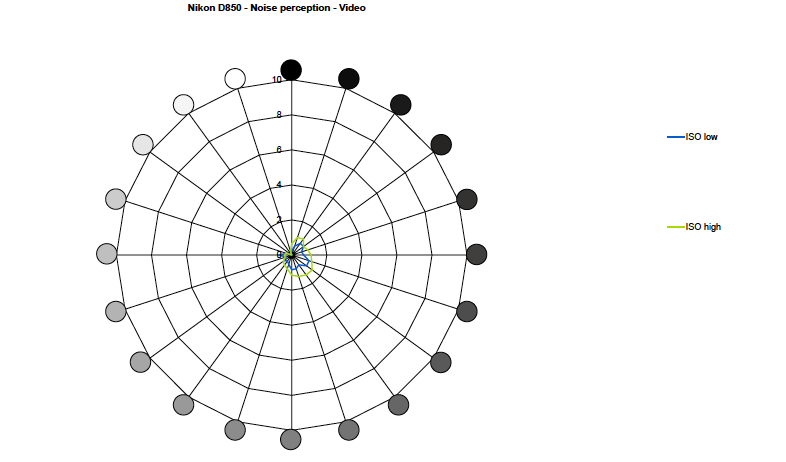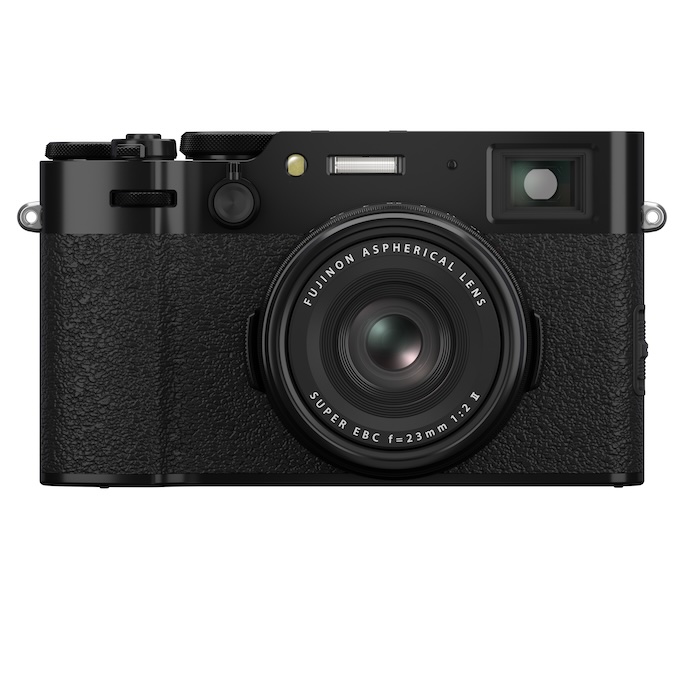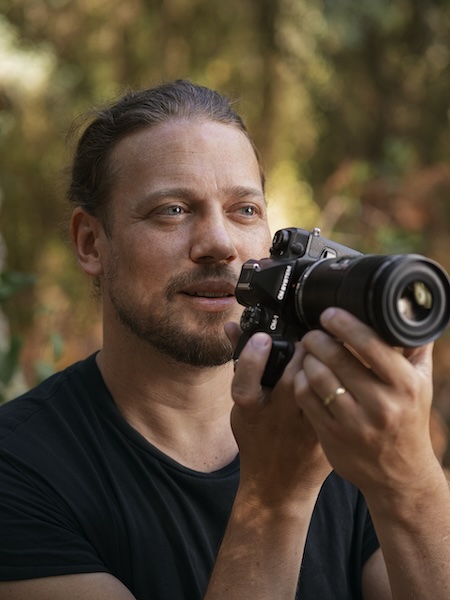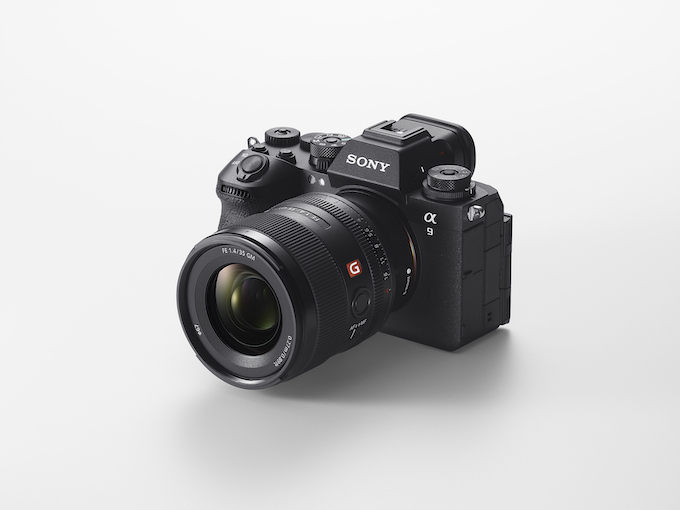Cameras
Lab Test: Nikon D850
October 4, 2017
Rangefinder is a member of the Technical Image Press Association which has contracted with Image Engineering to perform detailed lab tests of digital cameras. See here for a full methodological rundown of how Image Engineering puts cameras through their paces. We’ll feature a hands-on review of the D850 in an upcoming issue. Full res files of every visual in this review are available to download for your pixel-peeping pleasure here.
The Nikon D850 has a 45.7-megapixel sensor, and so it is not surprising that image quality tests show excellent performance. Sensor size is an important factor in image quality, although how the sensor performs is a more decisive factor. This is why precise measurements of resolution can be informative even when one knows the sensor size. The Nikon D850 performs well in the lab. For example, a measurement of 2591 line pairs per picture height captured by the D850 at ISO64 – 94 percent of the theoretical maximum – gives one an indication of the incredible amount of detail that can be recorded by the camera.

The Nikon D850 has better resolution than its predecessor Nikons D800 and D810, both of which had 36-megapixel sensors. The Nikon D850 lacks an anti-aliasing filter, allowing more detail to be captured, albeit with an accompanying risk of moiré in images. However, as moiré occurs when a visual pattern exceeds the resolution of the sensor, it is unlikely to be much of a problem for the D850.
The native ISO range of the Nikon D850 is impressively wide, from ISO64 to 25600. Lab measurements show excellent resolution at any ISOs likely to be needed. For example, at ISO 400, the Nikon D850 records 2389 line pairs per picture height (87 percent of the theoretical maximum).The Nikon D810 tested at the same ISO achieved 91% percent of the theoretical maximum, but, as the sensor had fewer pixels this represented fewer line pairs per picture height (2228). The D800 recorded only 1993 line pairs per picture height.
For the D850, only at the highest ISO tested (25600), does one see a decline in the generally excellent resolution. At ISO 25600, the Nikon D850 captures 1849 line pairs per picture height (67 percent of the theoretical maximum). However, even this lower performance in the absolute measure of line pairs per picture height, is not much less than the Nikon D810 at the lower speed of ISO 12,800 (1885 line pairs per picture height, 77%).

Capture of fine detail is very good in the Nikon D850, and there is little observable difference in fine texture at high contrast between ISO64 and ISO1600. At ISO400 in a high-contrast scene, the Nikon D850 produced an artifact score of 24.8%; at the same ISO, the Nikon D810 produced 40.1%. Few artifacts are present in images shot by the Nikon D850 of high contrast scenes at speeds ranging from ISO64 (25.3%) to ISO6400 (36.0%). However, low contrast scenes shot at ISO6400 (51.5%) and ISO12800 (61.8%) both show more artifacts, and the D850 has poorer scores than the D810. At ISO6400, a reproduction by the Nikon D850 of a photo of grass has lost some detail, compared with the same reproduction shot at lower ISO.
Contrasted edges in test images captured by the Nikon D850 at various ISOs, look natural to the eye when viewed at 100%. The Nikon images do not show the artificiality of a heavily sharpened edge. The sharpening curve indicates that the degree of overshoot and undershoot to be relatively moderate with modulations below 11% (with the exception of modulation of 11.6% at ISO2200). In comparison, the D810 produces less modulation (generally less than 5.5%) in its sharpening. However, undersharpening can cause images to look displeasingly flat (although this can be adjusted by the user in post-processing). The depth and extent of overshoot and undershoot are similar in the Nikon D850, in contrast to the D800 which produced more overshoot and relatively little undershoot.
The measurements of visual noise from the Nikon D850 show that noise occurs primarily in the darker end of the middle tones. The measurements of noise show relatively large amounts of noise, and that noise increases with increasing ISO. However, large amounts of noise is an expected effect with cameras with such large resolution. Images made by the D850 have less noise than those made by the D800. Comparing images made by the Nikon D850 at ISO1600 with one made at the same ISO by the Sony Alpha 9, another recent camera with a large sensor, one sees that the Nikon image is a little bit noisy although not enough to disturb. However, in order to view the Sony image at about the same size (100% for the Nikon D850), one must enlarge it to 135%, which results of course in a pixelated image. This is another way to demonstrate that the higher noise values in the Nikon will be balanced by the image improvements with the excellent resolution of the large sensor.
The dynamic range of the Nikon D850, when tested in accordance with ISO standard 15739, is smaller than some competitors’ and a little less good than the Nikon D800. The Nikon D850 shows a dynamic range of between f8.6 and f8.9 at between ISOs ranging from ISO64 to ISO3200. At ISO6400, a reproduction of a photo of stones and grass, shows a reduction in color capture (stones that are brownish are shown as slightly more grey than they are when reproduced using the Nikon D850 at lower ISOs). At ISO12800, the stones are shown only as grey.
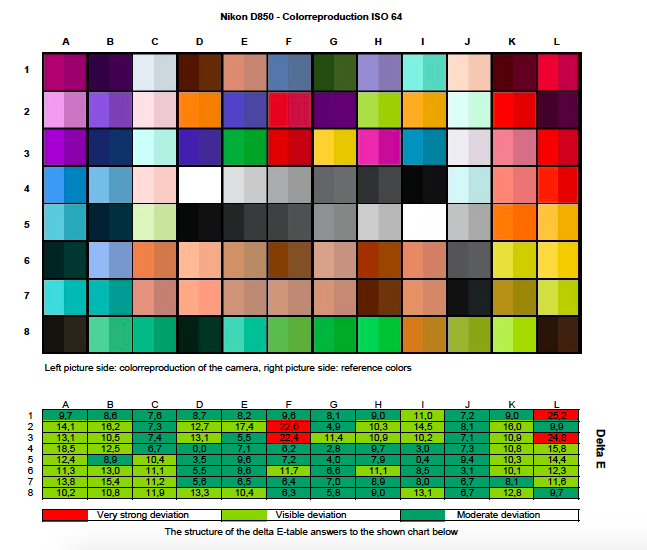
Color reproduction by the Nikon D850 is very good, with only few reds showing strong deviation from the reference color at ISO64. Color reproduction is consistent as ISO increases, showing the versatility of this camera for different ISOs. Color difference for this camera (∆E) ranges from 9.9 to 10.4 at ISOs from ISO64 through ISO6400. Even at ISO12800 it is only 10.7. This is better than the Nikon D800 which showed a fairly consistent ∆E score of over 11.
The automatic white balance shows excellent results (0,8) at ISOs through ISO6400. The white balance is similar between all these ISOs, meaning that pictures taken at a range of ISOs will show similar white balances. At ISO12800 (with a measurement of 1.1) and above, the white balance is still very acceptable.
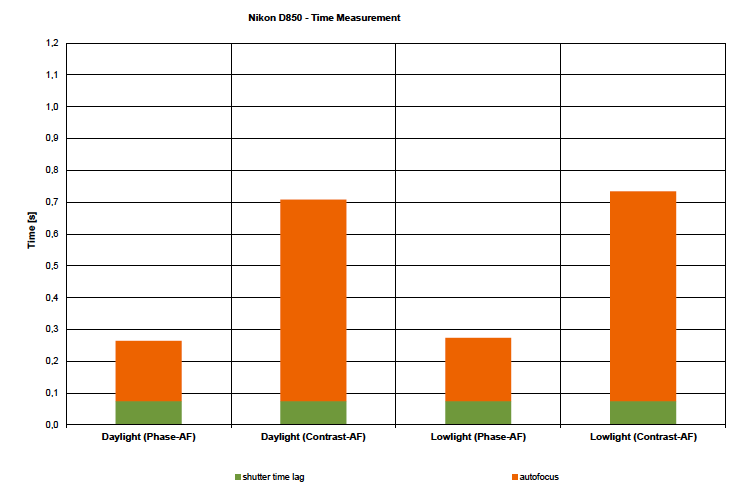
The camera’s start-up time is 0,2 seconds, which is hardly noticeable. The time lag between pressing the button and the shutter being released, is 0.08 seconds (without autofocus).
Autofocus is fairly fast: using the optical viewfinder autofocus takes 0.19 seconds in bright light and only a fraction longer in low light (0.20 seconds). When focusing using Live View, the autofocus is completed in 0.63 seconds in bright light and 0.66 in low light. The total time from pressing the release button until the camera is focused and the shutter released being 0.71 seconds in bright light, and 0.73 in low light. This is a lot faster than the D810, which took over a second to focus in Live View in both bright and low light conditions.
The Nikon D850 is able to shoot large files at a fairly fast rate. Tests show it can record 9.1 frames per second in RAW format – compared with 5.1 per second by the D810. The D850 can store 19 RAWs before slowing down, although the D810 could store 20. In JPEG format, the Nikon D850 shoots 9.2 frames per second in the best JPEG and can store 70 images before slowing down. In comparison, the Nikon D810 could shoot 5.1 JPEGs per second, and store 56.
Video
The image quality in video mode is consistently good at both low and high ISO, although the videos made by the Nikon D850 show nowhere near the excellent resolution of the still images. All measurements also show an improvement in video over the D810. Sharpening is moderate (657 and 361 overshoot and undershoot at low ISO), and texture loss is moderate. The most texture loss occurs at high ISO when capturing a low-contrast scene. There is less visual noise in all viewing conditions, of videos shot at high ISO compared to those produced by the Nikon D810. For example, at 100% (viewing condition 1), the noise score is 1.0 in the film made by the D850, and 1.9 in the one made by the D810.
